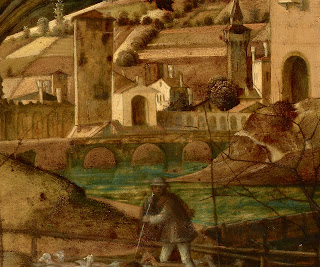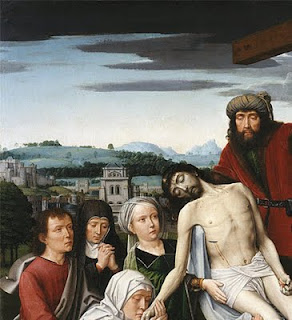Giovanni Bellini, Detail of St. Francis in the Desert, c. 1480,
oil on poplar panel, 49 x 55 7⁄8 in. (124.5 x 141.9 cm),
The Frick Collection, New York
Photo: Michael Bodycomb
The following is a continuation of the June blog post, A Radiant Masterpiece Reveals More - Part 1. The discourse considers The Frick Collection’s St. Francis in the Desert by Giovanni Bellini and the discoveries made last year during the painting’s five week technical analysis at the Conservation Center of The Metropolitan Museum of Art. This is also the subject of The Frick’s present exhibition, In a New Light: Bellini's St. Francis in the Desert.
Giovanni Bellini, St. Francis in the Desert, c. 1480,
oil on poplar panel, 49 x 55 7⁄8 in. (124.5 x 141.9 cm),
The Frick Collection, New York
Photo: Michael Bodycomb
Although the recent examination of Giovanni Bellini’s St. Francis in the Desert disclosed much that was new, the painting still remains an enigma. The study confirmed that the panel was in excellent condition and needed only surface cleaning to remove dust. Through infrared reflectography, it revealed Bellini’s previously concealed underdrawing. Since very few drawings, preparatory or otherwise, can be attributed to the artist, the uncovering of such designs is particularly important. Comparison between the underdrawing and painting that hid it, makes apparent the small as well as the noteworthy changes Bellini made to achieve the work’s final realization.
Giovanni Bellini, Infrared reflectogram detail of St. Francis in the Desert,
c. 1480, oil on poplar panel, 49 x 55 7⁄8 in. (124.5 x 141.9 cm),
The Frick Collection, New York,
Technical photography by Department of Paintings Conservation,
The Metropolitan Museum of Art Image © The Metropolitan Museum of Art
We see that at times the artist’s painted layers followed closely what was drawn such as in the rendering of the saint’s head and face. Mouth open, eyes searching upward, Francis expresses awe, surprise, ecstasy or a combination of these. For the drawing, the artist employed a variety of brushstrokes to create remarkable three-dimensionality. Thick or fine lines describe contours; hatching is used for modeling; and, a combination of hatching and crosshatching situate items in space. In some areas of the panel, Bellini made minor modifications as seen in the elimination of a door or chimney on a background edifice. In other instances, refinements made aesthetic sense such as the widening of the saint’s right sleeve.
Giovanni Bellini, Infrared reflectogram detail of St. Francis in the Desert,
c. 1480, oil on poplar panel, 49 x 55 7⁄8 in. (124.5 x 141.9 cm),
The Frick Collection, New York,
Technical photography by Department of Paintings Conservation,
The Metropolitan Museum of Art Image © The Metropolitan Museum of Art
Giovanni Bellini, Detail of St. Francis in the Desert, c. 1480,
oil on poplar panel, 49 x 55 7⁄8 in. (124.5 x 141.9 cm),
The Frick Collection, New York
Photo: Michael Bodycomb
At times the artist choose to redesign more. He transformed the background footbridge from a simple post-and-lintel type of construction which extended to the right bank into a more complex arch and vault bridge system that ended behind the shore edge. Moreover, during painting, Bellini added a back flat shelf to the slanting reading surface of the saint’s desk. On this he painted a cross with a crown of thorns and a skull.
The painting shows the moments after Francis was interrupted from his contemplation of the Passion of Christ - the final hours of Jesus’ life according to the New Testament. There is a bookmark to indicate the page where he stopped reading. His sandals are left in the enclosure when he hurriedly stepped outside on ground that may be perceived as holy. It is dawn and all is still. The lighting, more theatrical than real, is twofold - natural and sacred. The heavenly rays fall from the upper left of the sky onto Francis. The temporal morning light shines on the middle and far ground. In the distance, a shepherd and his flock look toward the saint as if to see what is happening.
Giovanni Bellini, Detail of St. Francis in the Desert, c. 1480,
oil on poplar panel, 49 x 55 7⁄8 in. (124.5 x 141.9 cm),
The Frick Collection, New York
Photo: ARTstor
A rabbit in the foreground comes out of his dark burrow to peer at the saint and the source of the supernatural beams. The painting is filled with flora and fauna. All are identifiable attesting to Bellini’s keen observation of the world. In fact, a botanist was brought to see the work and was able to describe each plant portrayed.
From the swaying, tall laurel tree on the left to the the small kingfisher bird under the water spout at the lower right, everything has meaning. The grapevine over the saint’s shelter evokes Christ as “the true vine” according to the Gospel of John 15. The laurel, whose leaves remain green all year, symbolizes triumph, eternity and the resurrection of Christ. The shepherd’s ram, as a leader of the herd, is another reference to Christ. The rabbit who needs protection alludes to those who hope for salvation through Christ in addition to denoting fertility and lust. The kingfisher, long a good omen, is associated with peace and prosperity. Even the spout protruding from the rocks is linked to the fountain of Muses in Greek mythology and thought to be a symbolic representation of imagination - as water flows through a spigot, imagination passes through the mind. Not incidentally, Bellini paints this detail not far from his signature.
From the swaying, tall laurel tree on the left to the the small kingfisher bird under the water spout at the lower right, everything has meaning. The grapevine over the saint’s shelter evokes Christ as “the true vine” according to the Gospel of John 15. The laurel, whose leaves remain green all year, symbolizes triumph, eternity and the resurrection of Christ. The shepherd’s ram, as a leader of the herd, is another reference to Christ. The rabbit who needs protection alludes to those who hope for salvation through Christ in addition to denoting fertility and lust. The kingfisher, long a good omen, is associated with peace and prosperity. Even the spout protruding from the rocks is linked to the fountain of Muses in Greek mythology and thought to be a symbolic representation of imagination - as water flows through a spigot, imagination passes through the mind. Not incidentally, Bellini paints this detail not far from his signature.
Giovanni Bellini, Detail of St. Francis in the Desert, c. 1480,
oil on poplar panel, 49 x 55 7⁄8 in. (124.5 x 141.9 cm),
The Frick Collection, New York
Photo: ARTstor
This brings to mind the meaning of the rabbit placed quite close to the saint’s right hand. Tucked into the cord around Francis’ waist is what looks like a folded piece of paper or parchment. It has been postulated that this is a depiction of the piece of parchment,(the original now kept as a relic in the Church of St. Francis at Assisi), on which Francis wrote a hymn to God as well as a benediction to Brother Leo. Along with the writing, the saint drew on it a cross and skull, similar to the cross and skull on the cloister desk. Legend has it that Francis told Leo to keep the parchment as protection against temptation. Could it be used to prevent the lure of concupiscence symbolized by the nearby rabbit? Bellini was a meticulous thinker and planner, what he put in a painting has signification.
As noted earlier, theories and interpretations about the painting are numerous. Some hold it was created for a church; others maintain it was made for a private patron. One hypothesis proposes the lighting in the painting echoes the natural light entering the church or chapel of its intended location. Others have posited the work relates to the Renaissance argument concerning the merits of painting versus poetry - which of the arts can best reproduce reality and express emotion. The work has been connected to Italian pastoral or popular devotional poetry. There is even the opinion that the saint is singing! The abundance of explications can lead to confusion. For me, the strongest argument comes from scholars who interpret the painting as a devotional image, conceived for religious contemplation. It facilitates mediation, stimulates conversation and, encourages the exchange of ideas. I regard it not as descriptive of a specific narrative but as an open-ended, thought-inspiring work. Regardless of explanations, Bellini’s visual creativity never wanes. Take the small, golden tassel protruding from the bottom pages of the saint’s closed book or the tiny, exquisite knot on the string attached to the cloister’s bell made surely to ease the saint’s grip when he rang the bell to signal the canonical hours. These captivating depictions are nearly impossible to see in reproductions. They require and reward attentive viewing of the actual painting. To look this way, makes perceptible passages of delight.
Gerard David, The Disposition, c. 1495-1500,
oil on linen (mounted on mahogany panel),
56 1/8 x 44 1/4 in. (142.5 x 112.4 cm),
The Frick Collection, New York
Photo: ARTstor
Let us return to the Living Hall and the space the St. Francis usually occupies. In its place is The Disposition by the Netherlandish painter, Gerard David (c. 1460-1523). The scene is Christ’s removal from the cross after His death. Joseph of Arimathea, who received permission to remove the body, is seen with Christ’s other followers along with the Virgin Mary, St. John the Evangelist and Mary Magdalene. The work was acquired by Frick the same year, in the same lot and from same collector as Bellini’s St. Francis.
Gerard David, Detail of The Disposition, c. 1495-1500,
oil on linen (mounted on mahogany panel),
56 1/8 x 44 1/4 in. (142.5 x 112.4 cm),
The Frick Collection, New York
Photo: ARTstor
Gerard David, Detail of The Disposition, c. 1495-1500,
oil on linen (mounted on mahogany panel),
56 1/8 x 44 1/4 in. (142.5 x 112.4 cm),
The Frick Collection, New York
Photo: ARTstor
Although The Disposition was painted about a century after the St. Francis, like the earlier work, the background contains a careful and precise naturalistic townscape with a variety of finely delineated structures. There are castles, towers, fortified walls, a church and windmill. Frick is known to have had a predilection for landscape paintings and this may account for his attraction to the work. Furthermore, there is a prominent skull at the foot of the cross. Although the skull denotes Calvary, the site of the Crucifixion, it has also long been a symbol of the transitory nature of earthly life, a reminder of mortality. Perhaps, in his late sixties, Frick had thoughts of his own end. Whatever the reasons for the purchase, we are lucky to have the David and, of course, the Bellini in New York for us to enjoy.
Note: The Frick has opened a Multimedia Room off to one side of the Garden Court where visitors may view videos on specific aspects of Bellini’s St. Francis in the Desert and look closely at the infrared photograph of the work’s underdrawing. The videos and related lectures are accessible on the museum’s Web site along with a link to the painting's Google Art Project gigapixal image. Susannah Rutherglen, The Frick's Andrew W. Mellon Curatorial Fellow, is responsible for the coordination of this extraordinary exhibit and deserves much acclaim.
In a New Light: Bellini's St. Francis in the Desert
May 22, 2011, through August 28, 2011
1 East 70th Street, Manhattan
Tuesday through Saturday, 10:00 a.m. to 6:00 p.m.
Tuesday through Saturday, 10:00 a.m. to 6:00 p.m.
Sundays, 11:00 a.m. to 5:00 p.m.
Closed Mondays and holidays












